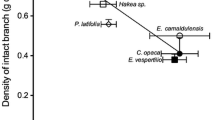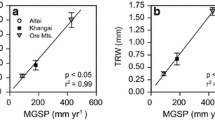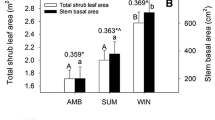Abstract
Possible tradeoffs between efficiency of water transport and mechanical strength were examined in stems of two congeneric pairs of co-occurring chaparral shrubs. First, since previously published results indicated that Adenostoma sparsifolium (Rosaceae) had greater specific conductivity (k s or hydraulic conductivity per xylem transverse area) than A. fasciculatum, it was hypothesized that A. sparsifolium would have greater vessel lumen area per square millimeter of xylem area, and less mechanical strength, than A. fasciculatum. Secondly, since Ceanothus megacarpus (Rhamnaceae) is a non-sprouter (unable to sprout from the root crown following fire or other major disturbance) whereas C. spinosus is a sprouter and thus able to form new stems following disturbance, it was hypothesized that C. megacarpus would have greater mechanical strength, but lower k s, than C. spinosus. Both hypotheses were supported. Based upon computer-aided image analyses, A. sparsifolum had significantly higher mean and maximum vessel diameters (16.4, 40.5 vs. 14.6, 35.7 μm), a 34% greater percent vessel lumen area, and a two-fold greater measured and theoretical k s than A. fasciculatum. This corresponded to 14% lower stem density (wet weight/volume) and less mechanical strength, with a 37% lower modulus of elasticity (MOE) and a 30% lower modulus of rupture (MOR) than A. fasciculatum. Similarly, C.␣spinosus had a significantly higher maximum vessel diameter (52.7 vs. 41.8 μm) and a 92% higher theoretical k s (and 43% higher measured k s) than C. megacarpus. This corresponded to a 9% lower stem density and 20% lower MOR than for C. megacarpus. Thus, at least within these two congeneric pairs of chaparral shrubs growing together in the same habitat, there may be tradeoffs between mechanical strength and conductive efficiency of the stem xylem which correspond to differences in transport physiology and life history traits of sprouter versus non-sprouter species.
Similar content being viewed by others
Author information
Authors and Affiliations
Rights and permissions
About this article
Cite this article
Wagner, K., Ewers, F. & Davis, S. Tradeoffs between hydraulic efficiency and mechanical strength in the stems of four co-occurring species of chaparral shrubs. Oecologia 117, 53–62 (1998). https://doi.org/10.1007/s004420050631
Issue Date:
DOI: https://doi.org/10.1007/s004420050631




